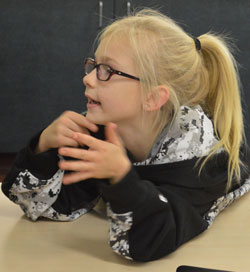Lucia “Luci” Kesner’s desk sits in a corner of teacher Melissa Austin’s first-grade class. A photo of the little girl hugging her teddy bear hangs above it, and atop the desk is a book titled, “Our Friend, Lucia.”
Luci is one of a crew of 25 in the Countryside Elementary School classroom, where her classmates know how much she loves books, her bear, her pink car and her cookie-jar toy. “To my kids, she’s one of us,” Austin said. “She’s a part of our classroom.”

Luci is completely homebound, but students have gotten to know her through weekly Facetime sessions, when the just-turned 7-year-old is projected on the screen, her wide eyes watching the classroom of energetic children as she listens to their greetings and questions. It’s always an exciting time, saying hello, practicing sign language and glimpsing Luci’s life.
“Can I read a question for Luci?”…“I can’t wait,” first-graders say as they prepare to connect on a recent morning. When Luci and her mother, Geneva Kesner, appear virtually, students read questions they’ve prepared, inquiring and chattering about lost teeth, favorite colors and Halloween. Luci, who is non-verbal, answers with a nod, head shake or other gesture, while Kesner fills in details.
The session ends with a chorus of “Byeee, Luci! Byeee!”

“These are her friends,” Austin said. “That was my goal – that they see her as just another first-grader in the class who happens to not be here in the room.”
Kesner said being included in the class is a new outlet for Luci. “She gets to make friends, see the world and interact with other kids. She’s learning what they are learning and she’s never had that before.”
Consistent Connections
Luci has a very rare metabolic disease called mucolipidosis type II. She is tiny for her age and cannot talk, sit, stand or walk. She breathes aided by a ventilator and is fed through a tube. She also must often have mucus suctioned from her lungs.
She has visited the class for recess and a Halloween party, but her weak immune system doesn’t allow her to visit often.

Austin said her students are learning that Luci is like them in many ways: she has feelings, likes, dislikes and favorite things. “It’s that concept of ‘there is something about us that is all the same – first.’”
Even on days they don’t communicate via Facetime, Austin includes Luci as part of the class in some way. Students practice sign language, choose a book to send home to her, or mention her throughout the day during various activities. Students love working at her desk and when there’s a classroom visitor, they introduce her even though she isn’t physically there.
Students have seen how Luci’s ventilator and suction process work and have learned about other aspects of her life.
Most importantly, they are learning to give someone a place to belong. “My role in is (providing Luci with) the social connection with kids her age,” Austin said. “It’s also about helping Luci and her family feel a part of the school.”

‘Her Eyes Light Up’
Luci is beloved by students and staff alike. A team of Byron Center teachers, a speech pathologist, occupational therapist and physical therapist work with her at home each week. She has learned numbers, letters and sounds.
“Her eyes light up and she has so much energy and so many ideas,” said speech pathologist Carrie VandeRoer about their sessions together. “Something we are working on this year is giving her a way to show her great ideas.”
Luci is learning to use an Augmentative Alternative Communication (AAC) device, which supplements or replaces speech or writing for people who can’t speak or write. “We are trying to build her independence so she can communicate and advocate for herself,” VandeRoer said.

Staff members hope to soon introduce her to a more advanced device that will allow her to put words together on a computer or iPad using her eyes, touch or a button.
Kesner said she sees her daughter retaining information and communicating more and more. She wants to do things herself. “She wants to be little Miss Independent.”
Students send Luci little notes, which she is always eager to get her hands on. “She’s very social, she’s always been social and she’s becoming more social,” Kesner said. “Her personality keeps growing.”
Luci’s classmates love to talk about her.
“She has a feeding button because she can’t chew,” Celia Ware said.
“Her muscles aren’t as strong as ours so she uses a chair she can lean back on,” Owen Reed said.

“She is just like us, and her favorite colors are just like mine,” said Kelsey Obiedzinski.
“She is the same age as us, and we are going to celebrate her birthday soon,” Isaac Manker said.
When given the chance to make a new friend, children step up, Austin said.
“It gives the first-graders an opportunity to rise to the occasion. They have the opportunity to build character that is going to make a difference for their whole lives, a compassion and understanding. It’s a life skill they are getting when they are 6.”












